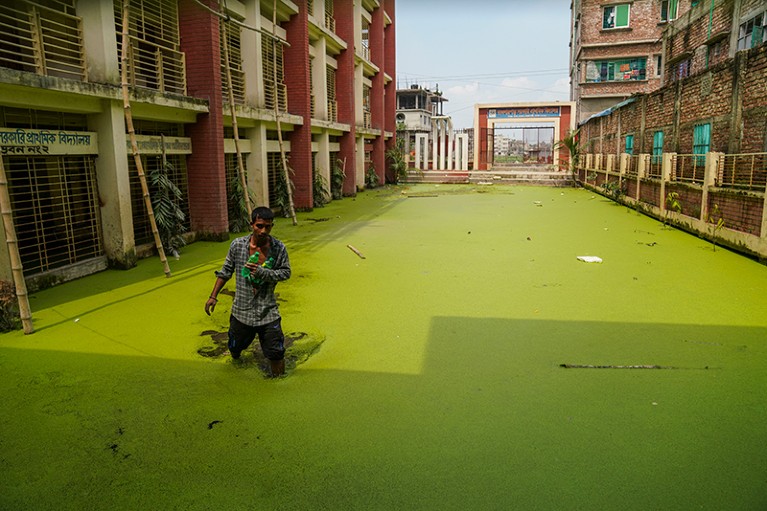
A man walks through stagnant water on ground floor of a primary school in Bangladesh.Credit: Zabed Hasnain Chowdhury/SOPA Images/LightRocket via Getty
Scanning waste water for viruses that infect the bacterium that causes typhoid fever — rather than the bacterium itself — could inform vaccine roll-outs, according to two studies conducted in Bangladesh1 and Nepal2, which have not yet been peer-reviewed.
The approach offers a proof of principle for cheap, quick and wide-scale surveillance, and can test the effectiveness of efforts to prevent the disease’s spread, says Senjuti Saha, a molecular microbiologist at the Child Health Research Foundation in Dhaka, who was involved in both studies.
Typhoid is caused by the bacterium Salmonella enterica serotype Typhi, which contaminates food and water. Every year it affects some 14 million people globally, causing fever and diarrhoea, and kills more than 135,000. It can be treated with antibiotics, but the rapid emergence of antibiotic-resistant strains led the World Health Organization to recommend in 2018 that countries with a high burden introduce vaccines. Countries across Asia and Africa are starting to immunize their populations, first targeting regions at high risk, such as those with poor-quality water and sanitation.
Public-health officials typically rely on numbers of infected people to identify communities to prioritize for vaccination campaigns, but these data are limited because they rely on testing at health facilities, to which many people in resource-poor regions don’t have access. Some researchers have tried to improve surveillance by testing for the presence of S. Typhi in waste water, but isolating the bacterium requires collecting large amounts of water and often doesn’t work. Molecular approaches that involve sequencing segments of DNA using a technique called polymerase chain reaction (PCR) are expensive.
In the latest studies, the researchers decided to instead hunt for the viruses that infect the bacterium, known as bacteriophages, or phages. Bacteriophages tend to survive longer in the environment than do their bacterial hosts. “If there are phages present, it means the host bacteria that they infect have to have been present,” says Ana Lanham, an environmental biotechnologist at the University of Lisbon. This information could inform efforts to minimize the spread of typhoid in those communities, she says.
River sewage
Table of Contents
The team that worked in Bangladesh collected some 300 water samples from sewers, rivers and lakes, as well as from stagnant pools that had settled after floods or heavy rain, from sites in Dhaka and Mirzapur, a rural town northwest of the capital, between August and December 2021. Samples of less than 10 millilitres were filtered to remove bacteria and large debris. The water was then dropped onto colonies of S. Typhi growing in ‘lawns’ in a Petri dish. If typhoid-specific bacteriophages were present, they killed the bacterium, forming clear patches in the otherwise lush lawns.
A similar approach is routinely used to test water for faecal contamination by screening for Escherichia coli and Bacteroides fragilis, bacteria commonly found in people’s guts, says James Ebdon, an environmental microbiologist at the University of Brighton, UK. This is probably the first time that scientists have used the approach to identify typhoid, he says.
But Ebdon says more work is needed to assess whether the bacteriophages can multiply under conditions that the bacterium cannot, to avoid overestimating typhoid prevalence in the community.
Bacteriophages were detected in some 31% of the 211 samples collected in Dhaka, a city known to have a high typhoid burden, compared with only 3% of the 92 samples from Mirzapur, which has a low burden. These results corresponded with data collected in hospitals — some 5% of 4,620 blood samples taken from the two largest paediatric hospitals in Dhaka contained S. Typhi, compared with just 0.05% of 3,788 samples from the largest hospital in Mirzapur.
The Nepalese team noticed a similar correlation. In Kathmandu, and in nearby Banepa — regions known to have a high prevalence of typhoid — around 55% of 361 river-water samples collected between November 2019 and October 2021 contained typhoid bacteriophages. River samples collected upstream were less likely to contain the phages. The researchers did not detect phages in river samples collected in sites farther east of the country, where typhoid is uncommon.
Kesia da Silva, a microbiologist at Stanford University, California, and an author of the Nepal study, says that growing bacteriophages requires only a small amount of water and brings significant cost-savings. For instance, testing a water sample for the bacterium using PCR costs around US$100, whereas it cost only $2 to identify bacteriophages using a Petri dish.
Community mapping
Da Silva says that she and her collaborators hope to use their approach in other regions where clinical data is limited but typhoid is common. “We have better data on typhoid burden in South Asia, but there are many other countries where we don’t have that,” she says.
Saha says her team recently received funding from the Bill & Melinda Gates Foundation in Seattle, Washington, to expand surveillance to the whole of Bangladesh. This will help to inform the government’s decision on where to prioritize vaccination schemes, including in areas where people have limited access to hospitals and clinics for blood testing. It will give a “very rapid idea of where the burden is”, she says.
